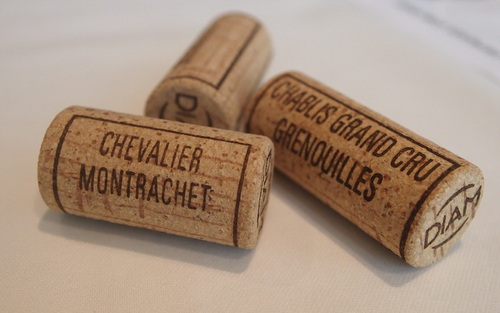
Celebrated Burgundy producer Domaine Leflaive have switched away from natural cork to DIAM for all their wines, beginning with the soon-to-be released 2014 vintage.
I was alterted to this news by a tweet from Neal Martin, and I spoke on the phone this morning with Adam Brett-Smith of exclusive UK agents Corney & Barrow, who confirmed that from Bourgougne Blanc to Montrachet, proprietor Brice de La Morandiere has decided to bottle everything with this alternative closure. Brice, Anne-Claude Leflaive’s nephew and great grand son of Joseph Leflaive, has been fine-tuning how things are done at the domaine, and this is one of the changes.
This is the highest profile estate to move away from natural cork, and as such, it’s big news. Others in Burgundy have already experimented or shifted altogether, and it’s likely that more producers of white Burgundy will now also make the switch. Some years ago Ponsot famously adopted the rather unusual ArdeaSeal, an exotic plastic cork. Benjamin Leroux has used screwcaps for all his whites from 2014, except for those wines destined for markets where he feels they won’t accept alternatives to cork. From 2013, Dominique Lafon has also been using DIAM.
The big problem facing white Burgundy over recent years has been premature oxidation (known as PremOx). After a few years of cellaring, within the same case some of the bottles might be drinking perfectly, while others will be oxidised. There’s been a lot of discussion about its cause(s), but it’s clear that one of the contributors is the cork. While the wines seem to have become more fragile, it is the variation in cork that shows this fragility up. A more consistent closure with very low oxygen transmission might make PremOx rarer, even if it can’t deal with the underlying causes (which still aren’t completely clear).
the PremOx problem came to light from the 1996 vintage onwards. After being relatively unscathed with this issue, Leflaive reportedly suffered very badly with PremOx from the 2006 vintage onwards. Perhaps this is one reason they were keen to shift from natural cork.
DIAM, which is a technological cork made from grinding up bits of natural cork, cleaning them with supercritical carbon dioxide, and then glueing them back together with synthetic microspheres, is seen as a possible solution. It is consistent, and allows just a little oxygen transmission, like a good cork might. I’ve always had good experiences with DIAM-sealed bottles, but some winemakers claim they can spot a wine sealed this way because it dampens the fruit a bit. Andrew Jefford discusses this in an article on DIAM here.
The other option that may well take off for white Burgundy is screwcap, with a tin/saran liner. There are concerns that these screwcaps can cause or exaggerate reductive tendencies in wine, but some of my favourite new world Chardonnay producers, including Kumeu River, Neudorf and Norman Hardie all use screwcaps and the wines are thrilling. It will be interesting to see whether or not Domaine Leflaive’s shift causes a mass move away from natural cork to alternatives such as DIAM and screwcap.
7 Comments on Domaine Leflaive’s switch to DIAM

I thought Domaine Leflaive was a shared agency between Armit Wines and Corney? Unless the status quo has changed since last releases? I’m sure corney would like to be exclusive!
Nice succinct discussion. Kumeu’s Chardonnays are thrilling young and with a few years of bottle age. The problem with grand white Burgundies is how they will evolve over a decade with alternative closures. Jadot switched to Diam entirely for whites with 2011 vintage. So far so good with Cotton Charlemagne, but jury is still out.
Hi Jamie,
Thanks for the news. It’s good to see a major domaine taking this step. I’ve cellared DIAM closed (red) wines back to 2008, and so far everything is totally up to scratch from my non-scientifically controlled cellar.
I am distressed that you linked Andrew Jefford’s column, since it’s both a retread from 2014, and impugns DIAM with purely anecdotal “evidence” in the very first paragraph. The piece does not seem to meet your high standards of science-based analysis, and so is quite out of place.
After 10 years using screwcap Laroche has gone back to natural cork. I wonder if Kumeu River will one day do the same?
A few years back James Rowan, winemaker at Westbrook Winery in Auckland, bottled the same Riesling under both screwcap and Diam. Several people, including James, were able to tell them apart in a triangular test.
James claimed scalping from the Diam. I thought perhaps the higher Total Package Oxygen (TPO) that comes with bottling under screwcap could have allowed this wine to be more expressive in its youth.
Wines bottled under screwcap will see a larger reduction in Free SO2 in the months following bottling due to a higher TPO. Higher levels of Free SO2 can have a masking effect. So, differences between the same young wine bottled under screwcap and Diam could be a result in Free SO2 differences rather than the closure directly impacting the wine. Just a thought…
But, like David Bueker says, good science based analysis is what’s needed.
In response to Greg’s comments Domaine Leflaive remains a shared agency between C&B and Armit Wines in the UK.
Interesting article Jamie. As alluded to it shall be even more interesting to see how this closure debate plays out.
Wish they had moved to screwcap but I suppose that is a step too far for the French and most in the old world
Jamie,
Which OTR model are they using? Diam 10?